If you journey through Transylvania, ‘the land across the forest’, (searching for Vlad Tepes, Vlad the Impaler or Dracula) and head towards Brasov along the banks of the Big Tarnava River, you will surely spot from quite afar the pointy towers of medieval Sighisoara City, with its centuries old fortress and churches. We traveled there by train one winter.
I give you the Transylvanian ‘Pearl‘ and the ‘Nürnberg‘, Sighisoara!
A brief history of Sighisoara
Nearly two millennia ago here rose a Roman castrum, a military fortified camp guarding one of the major Roman roads crossing Dacia. Today, Sighișoara is part of the touristic route known as Via Transilvanica. But more proof of local human settlements dates back to the Paleolithic (or Old Stone Age): the Wietenberg culture.

Sighisoara as we know it took shape during the late 12th-13th century when Saxon merchants and craftsmen settled here for a few reasons. Although the medieval history of Sighişoara started at the fortified Church on the Hill – the name “Castrum Sex”given to this place was first mentioned in writing in a document from 1280.
First, to defend against Tatar invasions the eastern and southern borders of the Hungarian Kingdom, formed at the beginning of the Middle Ages on the Pannonian Plain. This border was none other but the line of River Târnava Mare.
Second, in search of a better life. These settlers, who chose the banks of the slower Saes river to build their homes, were soon known as the Transylvanian Saxons. By the 14th century, Sighișoara was a well known royal center with the status of an urban settlement, Civitas de Segusvar, and by the 15th century its guilds had received the sole right to its administration.
As it was the custom during the Middle Ages, captains ruled such territories, or royal citadels, and these captains obeyed the Prince of Transylvania which, in turn, was a vassal of the King of Hungary.
Yet there was a third, less known reason. As the people already living in this land were Christians and the Pope loved converting new territories to Catholicism, the plan of populating this area with Saxons emerged. So, over the centuries, in Transylvania arrived first the military contingents, then the Saxon merchant settlers.
Dominican monks also settled here at the end of the 13th century, followed by the Franciscans.
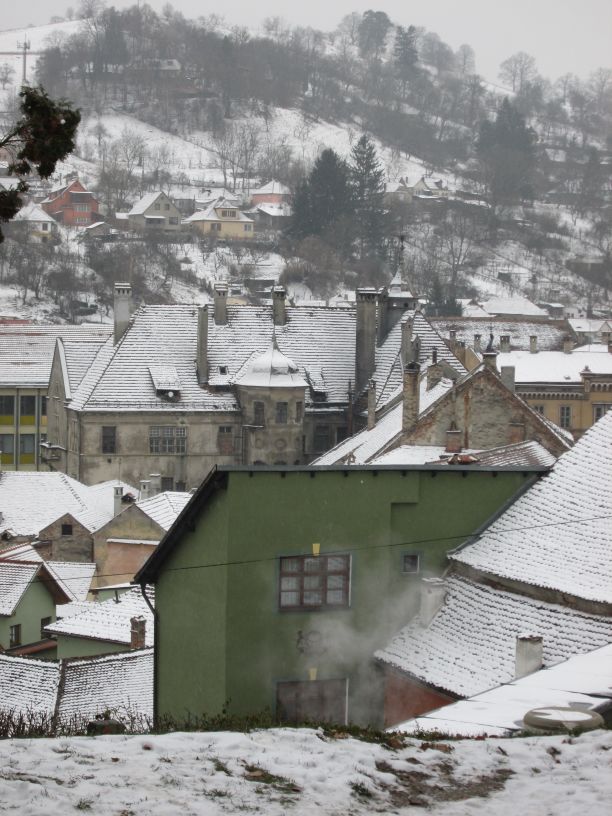
Today, a journey through the medieval city of Sighisoara is time-travel at its best, as this is one of the few preserved medieval cities still found in Europe and the only one fully inhabited found in Romania.
Sighisoara – the etymology of a town’s name
Castrum Sex, Castle Six, was the name of the fortress that existed here prior to the apparition of the first Hungarian military contingents. This fortress was first attested at the beginning of the 13th century, before being almost completely destroyed by Tatars.
Later we hear the name Castrum Sches, from Hungarian seges, or citadel, although it makes more sense to connect the fortress’ name with that of one of the rivers that run through it, river Şaeş.
Other names used for Sighisoara during the Middle Ages were Segusvar and Segeswar, as well as the German Schägesburh.
Vlad Dracul, Prince of Wallachia, was the first one to use the Romanian transcription of the town’s name, Schegischone, in a document from July 1st, 1435.
Sighisoara City – a layout with a purpose
One of the things I enjoyed about our journey around the medieval city of Sighisoara was that everything is within walking distance. Although the train station’s location is in the Lower City, Sighisoara’s modern area, it is easy to spot the walled fortress, atop a hill in the Upper City. The medieval citadel rises, colossal and gray, yet within close range, accessible through a bridge spanning across Tarnava Mare River.
Encircling Sighisoara fortress, one can very well admire the original defensive wall with its towers and bastions.
To recognize the craftsmen’s importance, each guild – and there were ten such associations in Sighisoara – received a tower of the citadel’s fortification. Thus, each guild was responsible for its own administration and it is still easy to guess which guilds were the most productive ones, as their towers are the best-preserved ones, and the biggest: Tailors’ Tower, Tin-makers’ Tower, and Goldsmiths’ Tower. But, above all, stands the 14th century Clock Tower and through here we made our entrance into the Sighisoara fortress.
The guilds were important as they fought against those who practiced the profession illegally. Also, their members enjoyed privileges with the Wallachian rulers.
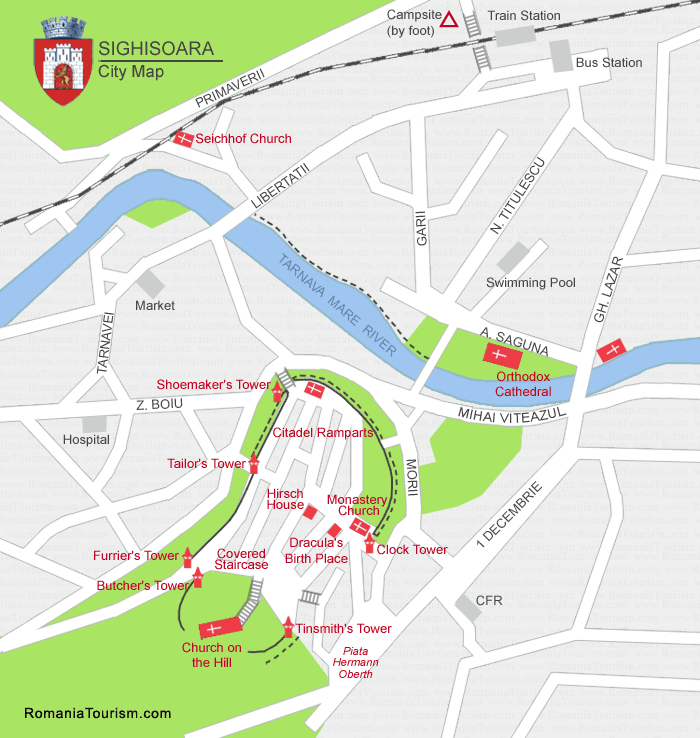
The story of the fortresses’ ramparts and towers
Apart from its 164 houses, what we admired the most during our journey through the medieval city Sighisoara were its 930 meters long defense wall and towers. Why so many – for such a small fortress?
During the Late Middle Ages, sadly, the danger of the Ottoman Empire escalated. Therefore, the first mention of a wall around Sighisoara fortress dates back to 1490. The very first wall elevation showcased crenelations and rose only 3-4 meters in height, principally intended for arbalesters (crossbowmen).
16th century came and the bastion rose by two extra meters. Meurtrieres were now built in the wall, either as floor-holes (for dropping hot substances onto the attackers) or as loopholes (arrow slits or cannoniers). After the big fire of 1676, the fortress’ wall was 8 – 10 meters in height.
Let’s make our way inside this incredible medieval fortress.
The Clock Tower
Placed on the eastern side of Sighisoara’s defense system of walls and towers, closer to sunrise, to mark its value, the Clock Tower was the first to welcome us on our journey. On a follow-up blog post we’ll have a detailed look at the other towers, each one with its own incredible history, but for now let’s start here.
The Clock Tower is the main entrance in the fortress and the first spot we visited during our journey through the medieval city of Sighisoara.
The Tailors’ Tower, on the opposing wall of the fortress, is the second way into the citadel.
Yet it is the Clock Tower that hides a few symbols.
Massive and everlasting, the Saxons built their Clock Tower out of a myriad of humble river stones handpicked from the banks of the nearby rivers. Each stone is insignificant on its own, their strengths coming from their number, much as a king’s army. Erected with the intention of being the main entrance in the fortress the Clock Tower, fortified accordingly, had only two levels. Its walls are 2.3 meters thick and three gates defend it, while its belly protects the stairway connecting the Upper City with the Lower City.
Only a handful of visitors know that the Clock Tower is a symbol of Transylvanian Saxons’ pride and craftsmanship. They desired to build the biggest, tallest clock tower in the principality – as horology had a long tradition here, since the 14th century.
The only path into the fortress takes you underneath the tower itself. It is the Front Gate ensemble and part of the tower’s barbicane, a fortified outpost.

In 1844, inside the barbicane a courtyard appeared, the Old Ladies’ Corridor that you can see here. This is a wooden passage meant to ease the aged peasants’ access into the fortress, during heavy winters.

Into the fortress we go, underneath the Clock Tower, through the belly of the beast:
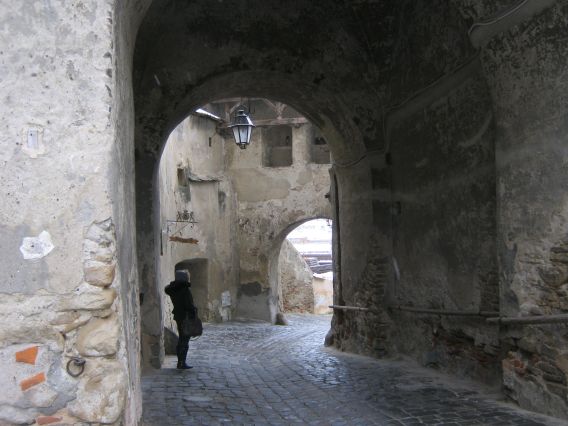
And emerging into the fortress. The visitors’ entrance in the Clock Tower is immediately on the right-hand side. The ground level of the tower dates back to the 14th century.
Similar to the second gate tower, the Tailor’s Tower, the Clock Tower has a rectangular floor plan and a ground floor with two vaulted gates over the passageway.
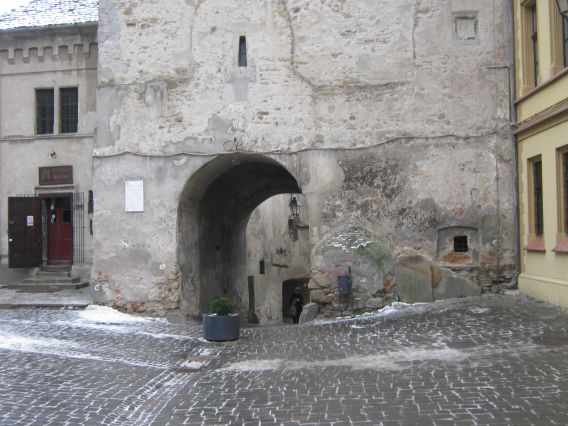
Hard to guess, but the Clock Tower, or the Big Tower of the Front Gate, reaches a height of 64 meters, of which 34 meters is the roof alone!
I admired the central, pointy roof with its baroque embellishments and its own main tower surrounded by four smaller ones, each rising at 12.5 meters. These four towers are a symbol of the city’s own judicial autonomy, right of the sword, meaning that back in the Middle Ages the Sighisoara City Council could give the death sentence and executions were also performed in the City Square.
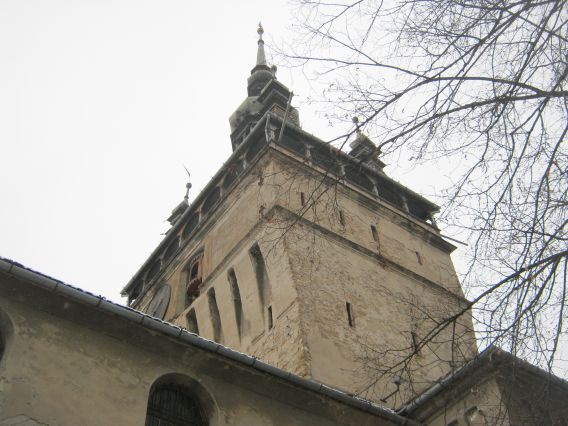
Unlike the other wall towers, each belonging to a guild, the Clock Tower belonged to the public authorities serving as headquarter for the City Council. Master builders added the upper levels during the 15th and 16th centuries and when the great fire of 1676 destroyed the roof, Austrian craftsmen built a new one in 1677.
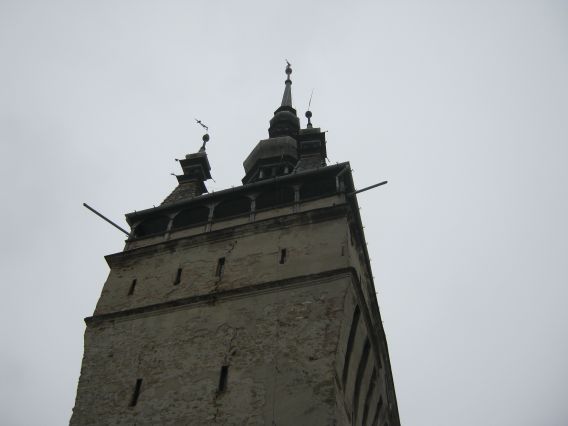
At the very top is a golden sphere, atop which a wind vane in the shape of a rooster still stands. The bulb-shaped roof stands as the oldest proof of Baroque influence in Transylvania.
The golden sphere is a symbol of local power and has a diameter of 1 meter. Why? Because it is a time capsule hidden in plain sight. Inside you would find a copy of the Chronicles of the Clock Tower by Georgius Krauss as well as documents pertaining to the history of Sighisoara and that of the Transylvanian Saxons.
The Sphere, the Crescent and the Double-headed Eagle of Sighisoara
At the very top of the Clock Tower is a rooster weather-vane. But underneath, between the rooster and the golden sphere, now this is an entirely different story.
We now see the double-headed eagle, a symbol of the Austrian Empire between 1867 and 1915.
During the tower’s refurbishing from 1677 the three builder masters placed here a Turkish crescent, surely under political orders, meant to remind the people of Sighisoara of the Ottoman Empire’s ruling.
The crescent got damaged in 1704 by local insurgents or curuti, from Hungarian kuruc. New work on the Clock Tower was only possible in 1776. Then the double-headed eagle, in a nod towards the Austrian Empire’s authority, replaced the crescent.

The roof, as we see it today, dates back to the 19th century. It uses hexagonal, glazed shingle tiles in shades of red, yellow, blue, green, and white. Mostly birds, able to fly this high, can enjoy such intricate details.

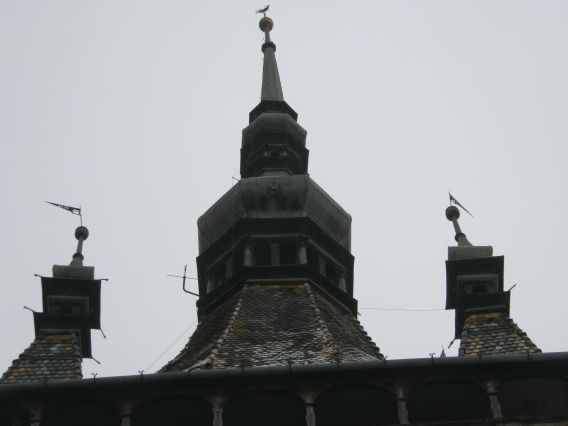
Yes, we climbed to the very top, to the balcony you see above – the sixth level of the Clock Tower.
Imagine living here in the late Middle Ages. The Tower, the tallest structure for miles, protecting you, and beside the sun, the keeper of time and your only measure for the time of day and the day of the week. Yet the tower was much more than that, for during important celebrations an orchestra would climb to the balcony placed at its very top and perform music that reached every corner of the fortress as well as those living outside its walls, in the Lower City.
And looking up at this medieval giant you will want to watch out, as the slits and murder holes are still visible:

The two faces of Sighisoara’s Clock Tower
Well worth noticing as you journey towards and through the medieval city of Sighisoara are the two faces of the Clock Tower, on its fifth level.
The best feature of the Clock Tower is on the fifth level, its 17th-century clock mechanism. In 1648 craftsman Johann Kirtschel even improved its system. He included a minute hand, added quarter-hour chimes and the one-meter tall wooden statues representing the days of the week.
Facing the Upper City or the inner fortress we can see a niche carved in the tower, holding statues and located to the left side of the 2,4-meter diameter clock dial.
Here, Peace holds a trumpet and an olive branch, near a Drummer who marks quarter hours and full hours.
Also, two statues in blue dresses symbolize Righteousness, with her eyes covered, holding a raised wooden sword and Justice, with laurels on her head, holding a scale. Yes, here Righteousness has her eyes covered and not Justice.
Later, two more statues appeared here, placed right at the top, two angels. At 6 AM the Angel of Day shows up, with flames above his head, holding a burning heart, replaced at 6 PM by the Angel of the Night, holding a torch in each hand.
On the clock’s side facing the Lower City, we can admire a horse and a drummer as well as seven 80 cm tall statues depicting seven Roman gods, symbols of weekdays: Diana / Artemis, Mars, Mercury, Jupiter, Venus, Saturn, and the Sun.

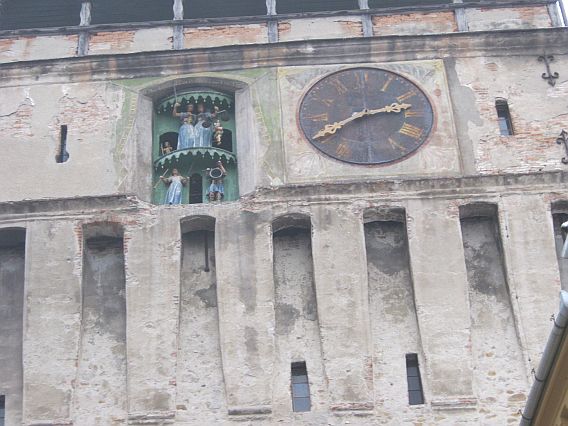
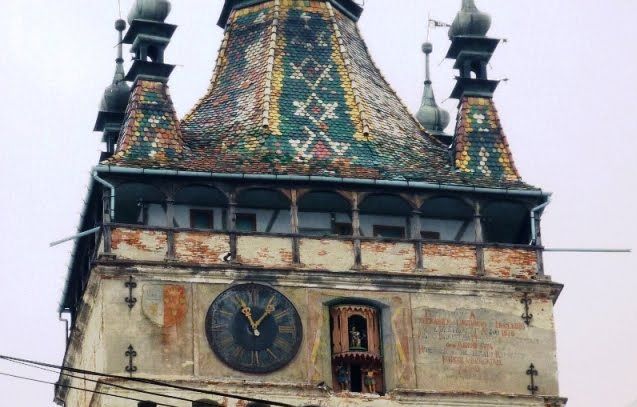
The Seven Statues of Sighisoara’s Clock Tower
Diana / Artemis, the goddess of hunting, depicted in a blue dress holding a bow and arrow; she has a half-moon over her head, the alchemist’s symbol for silver.
Mars / Ares god of war, holds a spear and wears a helmet with a feather, and above is the chemical symbol for iron, also a symbol for the star sign Ares.
Mercury / Hermes, the god of commerce, holds a caduceus in his right hand and a bag with money in his left and has a pair of wings at his helmet and another pair at his heels. Above his head is the symbol for mercury or quicksilver – just like his temper.
Jupiter / Zeus, the god of sky and the King of gods, depicted with his right foot resting on a globe, holds a lightning rod in his right hand and a thunder in his left. Above his head we find the alchemy symbol for tin, looking like a 24.
Venus / Aphrodite, the goddess of beauty and love, has the alchemy’s symbol for copper, passion, above her head and a winged cupid.
Saturn, the god of agriculture and abundance, has the symbol for lead above his head.
Sun / Sol / Helios, depicted as a female goddess with a crown of golden rays, the symbol for gold.
The Warning Statue, a Vestige of Sighisoara’s Medieval Past
But the traveler is also warned on his journey, long before he approaches the medieval city of Sighisoara. Can you read the signs?
Two lone statues are easily spotted underneath the seven peaceful ones, depicting days of the week and crafty symbols. One of these two statues is a drummer, matching the one on the other side of the clock tower, and hammering away as the bells chime.
Lo and behold for next to him stands an executioner, who once held in his hands a whip and a hatchet…
Going up into the medieval Clock Tower of Sighisoara
220 years old, the Clock Tower’s museum is a place worth visiting. One can admire coins, weapons, medieval pharmacy equipment and a detailed layout of the fortress.
Up until 1566, the rooms located on the tower’s first floor accommodated the Council’s City Hall.
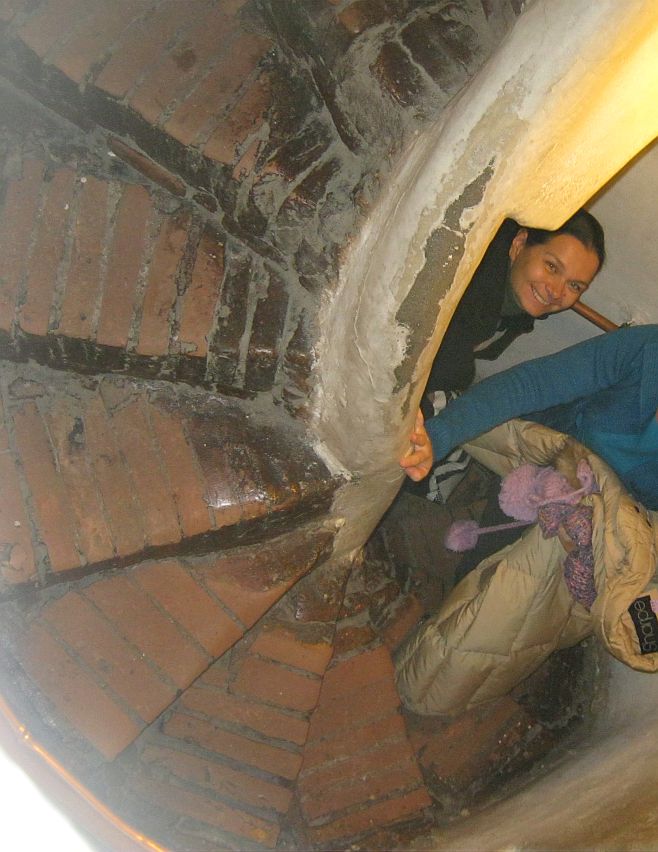
But what you do want to visit is the roofed gallery at the very top, hugging the clock tower all around.

Up here a 360 degrees panoramic view of Sighisoara unfolds in front of your eyes.

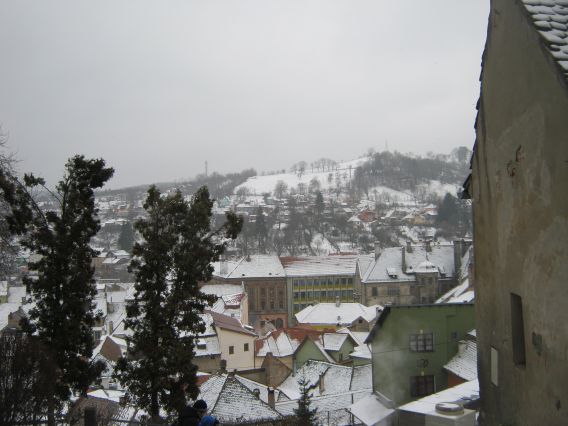
If you dare count, you will see over 150 medieval houses clustered in the old town, their red roofs and the stone-paved streets where once kings, artisans, and even Vlad Tepes strolled.

There, on the left, below, is the house where Vlad Tepes, Vlad the Impaler, Dracula, was born. We’ll go there soon. Meanwhile, have you noticed the slanted roofs powdered with snow?


From the top of the Clock Tower, we even had a glimpse back in time, through the history of Sighisoara. The Church on the Hill, dating back to the beginning of the 14th century, was one of the first constructions the Transylvanian Saxons built:
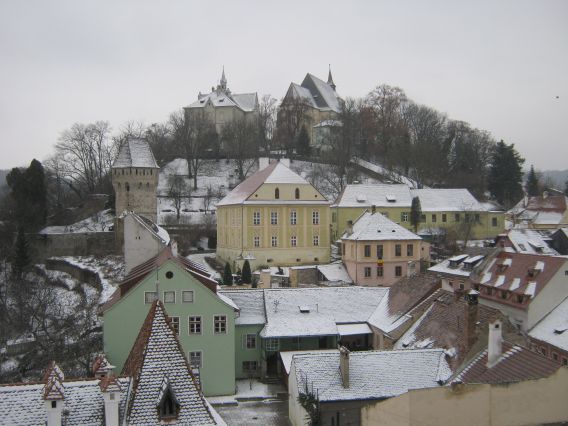
From the Clock Tower’s top balcony one can get a panoramic view of the world as well. How good is your eyesight? Can you see as far as Moscow?

Measuring from the Clock Tower, Vienna is 656 km away, Rome 1.096 km, Paris 1.680 km, London 1.872 km, New York 7.431 km, Tokyo 8.890 km, and Sydney 15.438 km away.
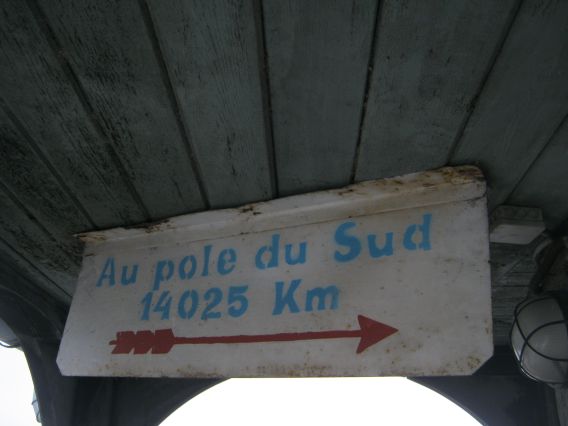
It looks like someone has left a secret message for us. Can you decipher it?
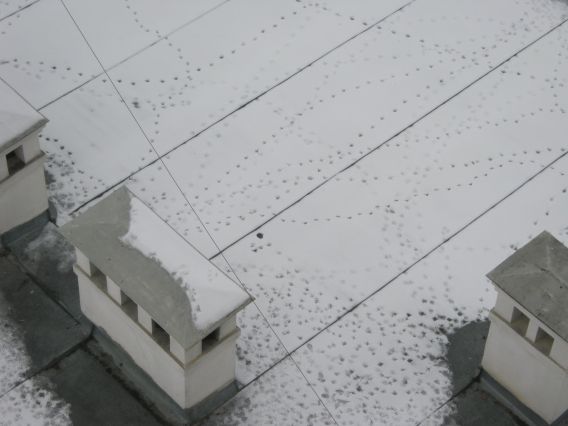
As a child, Vlad would have played hide-and-seek through this passageway when he was a lad of five. Lucky times as later, during the 18th century, this small space became a prison. For when the Clock Tower was first built there were two dark passageways running through it – what better place for children to play?
After the great fire of 1676, when the tower was rebuilt, one of these passageways became a torture chamber / jail. In this very space the convicts had their hands and feet tied in chains. As a way of torture the convicts were tied to the infamy pole, in the city square, with 6 kilograms river stone hanging around their necks, for all to see.

Go ahead, take a peek:

I am sure that, as a child, Vlad would have engaged in snowball fights and even built animals out of snow. On the patch of snow you see above, we built a dragon to honor Vlad’s name derived from the Order of the Dragon awarded to his father:

I hope you enjoyed our journey through the medieval city Sighisoara thus far.
If I were you, I would follow this blog as there are three more legs to this journey: a visit inside at the house where Vlad Tepes, (Vlad the Impaler or Dacula) was born, a walk around the medieval towers of Sighisoara fortress, as well as a pair of horns on a building, a mysterious stairway, and a graveyard.

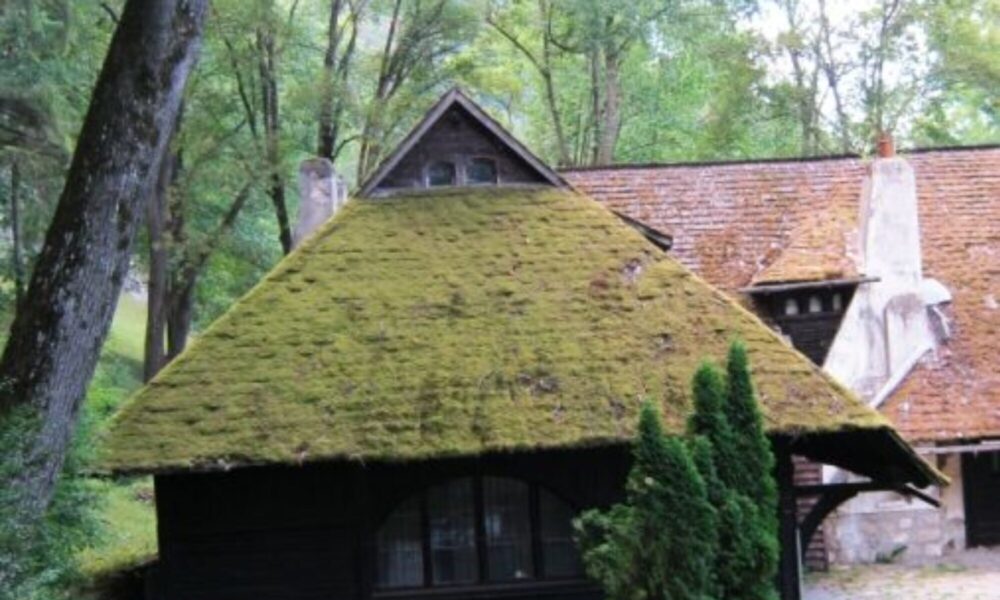

Hi Patricia,
I have never been to Romania, so thanks for the tour.
Good luck with your books, and thanks for following my blog.
Best wishes, Pete.
Hi Pete,
With great pleasure. I am so happy to hear that you enjoyed the tour. There are three more posts on Sighisoara, so do stay tuned 🙂
It is a fascinating country to visit, Romania, and I would recommend it to anyone, without bias 🙂
Thank you for your kind words and for stopping by.